NCERT Solutions Class 9 Maths
Chapter – 8 (Quadrilaterals)
The NCERT Solutions in English Language for Class 9 Mathematics Chapter – 8 Quadrilaterals Exercise 8.2 has been provided here to help the students in solving the questions from this exercise.
Chapter 8: Quadrilaterals
Exercise – 8.2
1. ABCD is a quadrilateral in which P, Q, R and S are mid-points of the sides AB, BC, CD and DA (see Fig 8.29). AC is a diagonal. Show that:
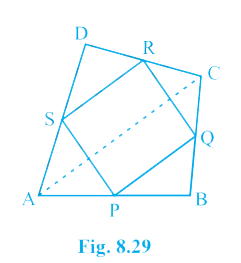
(i) SR || AC and SR = AC
(ii) PQ = SR
(iii) PQRS is a parallelogram.
Answer – We will use the mid-point theorem here. It that states that the line segment joining the mid-points of any two sides of the triangle is parallel to the third side and is half of it.
(i) SR || AC and SR = AC
In ΔADC, S and R are the mid-points of sides AD and CD respectively. Thus, by using the mid-point theorem
∴ SR || AC and SR = AC —————– (1)
(ii) PQ = SR
In ΔABC, P and Q are mid-points of sides AB and BC. Therefore, by using the mid-point theorem,
PQ || AC and PQ = AC —————– (2)
Using Equations (1) and (2), we obtain PQ || SR and PQ = SR —————– (3)
∴ PQ = SR
(iii) PQRS is a parallelogram.
From Equation (3), we obtained PQ || SR and PQ = SR
Clearly, one pair of opposite sides of quadrilateral PQRS is parallel and equal. Hence, PQRS is a parallelogram.
2. ABCD is a rhombus and P, Q, R and S are the mid-points of the sides AB, BC, CD and DA, respectively. Show that the quadrilateral PQRS is a rectangle.
Answer – We will use the mid-point theorem here. It states that the line segment joining the mid-points of any two sides of the triangle is parallel to the third side and is half of it.

In ΔABC, P and Q are the mid-points of sides AB and BC respectively.
∴ PQ || AC and PQ = AC (Using mid-point theorem) ————- (1)
In ΔADC,
R and S are the mid-points of CD and AD respectively.
∴ RS || AC and RS = AC (Using mid-point theorem) ————- (2)
From Equations (1) and (2), we obtain
PQ || RS and PQ = RS
Since in quadrilateral PQRS, one pair of opposite sides is equal and parallel to each other, it is a parallelogram.
Since the sides of a rhombus are equal, AB = BC
× AB =
× BC
PB = BQ (P and Q are the mid-points of sides AB and BC respectively)
∠QPB = ∠PQB (Sides opposite to equal angles are equal) ————- (3)
In ΔAPS and ΔCQR,
AP = CQ (P and Q are the mid-points of sides AB and BC respectively)
AS = CR (S and R are the mid-points of sides AD and CD respectively)
PS = QR (Opposite sides of a parallelogram are equal)
BY SSS congruency, ΔAPS ≅ ΔCQR
So, ∠APS = ∠CQR (By CPCT) ————- (4)
Since AB is a straight line, ∠APS + ∠SPQ + ∠QPB = 180°
Since BC is a straight line, ∠PQB + ∠PQR + ∠CQR = 180°
∠APS + ∠SPQ + ∠QPB = ∠PQB + ∠PQR + ∠CQR
∠APS + ∠SPQ + ∠QPB = ∠QPB + ∠PQR + ∠APS (By equations (3) and (4))
∠SPQ = ∠PQR ————- (5)
Since ∠SPQ and ∠PQR are interior angles on the same side of the transversal PQ, they form a pair of supplementary angles.
∠SPQ + ∠PQR = 180°
2 ∠SPQ = 180° [From (5)]
∠SPQ = 90°
Clearly, PQRS is a parallelogram having one of its interior angles as 90°.
Hence, PQRS is a rectangle.
3. ABCD is a rectangle and P, Q, R and S are mid-points of the sides AB, BC, CD and DA, respectively. Show that the quadrilateral PQRS is a rhombus.
Answer – We will use the mid-point theorem here. It states that the line segment joining the mid-points of any two sides of the triangle is parallel to the third side and is half of it.
Let us join AC and BD. In △ABC,
P and Q are the mid-points of AB and BC respectively.
∴ PQ || AC and PQ = AC (Mid-point theorem) ————- (1)
Similarly, in △ADC,
SR || AC and SR = AC (Mid-point theorem) ————- (2)
Clearly, PQ || SR and PQ = SR [From equation (1) and (2)]
Since in quadrilateral PQRS, one pair of opposite sides are equal and parallel to each other, it is a parallelogram.
∴ PS || QR and PS = QR (Opposite sides of the parallelogram) ————- (3)
In △BCD, Q and R are the mid-points of side BC and CD respectively.
∴ QR || BD and QR = BD (Mid-point theorem) ————- (4)
However, the diagonals of a rectangle are equal.
∴ AC = BD ————- (5)
Thus, QR = AC
Also, in △BAD
PS || BD and PS = BD
Thus, QR = PS ————- (6)
By using Equations (1), (2), (3), (4), and (5), we obtain
PQ = QR = SR = PS
Therefore, PQRS is a rhombus.
4. ABCD is a trapezium in which AB || DC, BD is a diagonal and E is the mid-point of AD. A line is drawn through E parallel to AB intersecting BC at F (see Fig. 8.30). Show that F is the mid-point of BC.
Answer – Given: ABCD is a trapezium in which AB || DC, BD is a diagonal and E is the mid-point of AD.
To prove : F is the mid-point of BC.
BD intersected EF at G.
In ΔBAD,
E is the mid point of AD and also EG || AB.
Thus, G is the mid point of BD (Converse of mid point theorem)
Now,
In ΔBDC,
G is the mid point of BD and also GF || AB || DC.
Thus, F is the mid point of BC (Converse of mid point theorem)
5. In a parallelogram ABCD, E and F are the mid-points of sides AB and CD, respectively (see Fig. 8.31). Show that the line segments AF and EC trisect the diagonal BD.
Answer – Given : ABCD is a parallelogram. E and F are the mid-points of sides AB and CD, respectively.
To Prove : AF and EC trisect the diagonal BD.
ABCD is a parallelogram, AB || CD
also, AE || FC
Now,
AB = CD (Opposite sides of parallelogram ABCD)
⇒ AB =
CD
⇒ AE = FC (E and F are midpoints of side AB and CD)
AECF is a parallelogram (AE and CF are parallel and equal to each other)
AF || EC (Opposite sides of a parallelogram)
Now,
In ΔDQC,
F is mid point of side DC and FP || CQ (as AF || EC).
P is the mid-point of DQ (Converse of mid-point theorem)
⇒ DP = PQ —————— (1)
Similarly,
In ΔAPB,
E is midpoint of side AB and EQ || AP (as AF || EC).
Q is the mid-point of PB (Converse of mid-point theorem)
⇒ PQ = QB —————— (2)
From equations (1) and (2),
DP = PQ = BQ
Hence, the line segments AF and EC trisect the diagonal BD.
Hence Proved.
6. Show that the line segments joining the mid-points of the opposite sides of a quadrilateral bisect each other.
Answer – Let ABCD be a quadrilateral and P, Q, R and S the mid points of AB, BC, CD and DA, respectively.
In is the mid-point of and is the mid-point of In is the mid-point of and is the mid-point of Line segments joining the mid-points of two sides of a triangle is parallel to the third side and is half of of it.
and ——————-
and ——————- From and and So, In one pair of opposite sides is parallel and equal.
Hence, is a parallelogram.
and are diagonals of parallelogram So, and since diagonals of a parallelogram bisect each other.
Hence proved.
7. ABC is a triangle right angled at C. A line through the mid-point M of hypotenuse AB and parallel to BC intersects AC at D. Show that
(i) D is the mid-point of AC
(ii) MD ⊥ AC
(iii) CM = MA = ½ AB
Answer – By converse of mid-point theorem, we know that a line drawn through the mid-point of any side of a triangle that is parallel to another side bisects the third side.
(i) D is the mid-point of AC
In ΔABC,
It is given that M is the mid-point of AB and MD || BC.
∴ D is the mid-point of AC. [Converse of mid-point theorem]
(ii) MD ⊥ AC
As DM || CB and AC is a transversal,
∠MDC + ∠DCB = 180° [Co-interior angles]
∠MDC + 90° = 180°
∠MDC = 90°
∴ MD ⊥ AC
(iii) CM = MA = ½ AB
Join MC
In ΔAMD and ΔCMD,
AD = CD (D is the mid-point of side AC)
∠ADM = ∠CDM (Each 90°)
DM = DM (Common)
∴ ΔAMD ≅ ΔCMD (By SAS congruence rule)
Therefore, AM = CM (By CPCT)
However, we also know that AM = AB (M is the mid-point of AB)
∴ CM = AM = AB

Leave a Reply